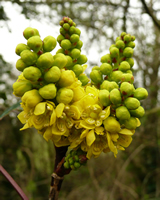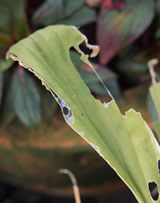

Ornamental plants
- This is the main rose pruning season. You can cut back modern bush roses, climbing roses, patio roses, ground cover roses, shrub roses and species roses.
- Prune back or coppice/pollard buddlejas, dogwoods, willows, cotinus, ornamental elders and eucalypts to control their size or ornamental effects.
- Old shrubs, deciduous hedges and climbers can be renovated this month.
- Cut back fuchsias in your greenhouse and start to spray them with water on sunny days to encourage them to start growing again.
- Prune climbers such as summer flowering clematis. This is also a good time to undertake renovation pruning of climbers.
- Trim winter flowering heathers when they've finished flowering.
- Cut lavatera (mallow) stems down to ground level.
- Cut back the foliage from epimediums.
- Sow hardy annual and wildflower seeds outdoors.
- Sow half-hardy and tender annuals in the greenhouse ready to plant out in the warmer weather.
- Pot up begonia tubers, gloxinia tubers, arum lily rhizomes, canna rhizomes, achimenes rhizomes, lily of the valley crowns, ginger lily rhizomes and dahlia tubers to start them growing in a frost free spot.
- Plant new perennials and lift congested ones to divide them up (eg hostas, rudbeckias, heleniums, peonies and asters).
- Plant out gladioli corms and lily bulbs.
- If you've ordered plug plants, pot them up as soon as they arrive.
- Brighten up your containers and pots with spring bedding, flowering spring bulbs and small evergreens.
- Scrape the top layer of compost away from permanent container displays and replace it with fresh compost.
- This is your last chance to move deciduous shrubs/trees and plant bare rooted ones.
- Top dress the soil in beds and borders with a slow release fertiliser, raking it into the surface slightly.
- As the soil warms up you can sow lettuce, rocket, radishes, spring onions, leeks, onions/shallots (seeds or sets), broad beans, parsnips, spinach, turnips, and early varieties of carrots and peas.
- Start sowing annual herbs and lifting perennial herbs if you want to divide them.
- Plant Jerusalem artichokes.
- Plant out rhubarb, strawberry plants and pot grown fruit trees/bushes.
- Protect early crops with horticultural fleece, particularly if frost is forecast.
- In the greenhouse you can sow tomatoes, chillies, bell peppers and aubergines.
- Continue chitting early seed potatoes.
- Harvest sprouting broccoli, Swiss chard and the last of the Brussels sprouts.
- Fork over bare earth in beds, borders and veg/fruit patches, removing weeds and mulching as you go.
- Make sure you have your slug/snail protection in place to protect new growth.
- Apply a spring feed (or 'weed and feed') to your lawn.
- Start mowing your lawn as soon as it's dry enough, starting with a longer cut and gradually shortening it (unless you have spring bulbs naturalised in it).
- Scrub or pressure-wash patios and paths to get rid of the winter muck.
- Clean your greenhouse out if you didn't do it in the autumn.
- Start recycling household rubbish to make plant pots, such as egg boxes, toilet roll tubes or yoghurt pots.
 Plant of the month
Plant of the monthMahonia x wagneri 'Pinnacle' starts to display its wonderfully bright flowers this month. It's an often underrated plant which is drought tolerant and ideal for low maintenance gardening. It forms an upright shrub which is up to 1.5m tall and 2m wide. The glossy, evergreen leaves provide year round interest and the flowers are followed by purple/black berries. Find out more...


Snails emerge from their winter inactivity this month. They can be a particular problem for seedlings and young plants. Irregular holes in foliage and a silvery slime trail are good indications of a snail (or slug) problem. If you haven't already done winter digging then doing it early this month can expose and kill eggs before they hatch. Otherwise there are various controls you can try, including chemical controls in the form of slug pellets. Find out more...

Pressure grows to ban neonicotinoid
The European Union has stated that it wants member nations to restrict the use of neonicotinoid pesticides, which are believed to harm bees and be linked to the recent decline in the bee population. Many garden centres have already removed these products from sale following a forceful Facebook campaign and Friends of the Earth have drawn up a letter for activists to use in voicing their concerns to sellers of neonicotinoid products.
New gardens and green spaces
The National Trust has announced 20 major garden openings and developments this year. These include the restoration of Canons Ashby (Northamptonshire), a hidden garden to be created at The Vyne (Hampshire) and a new rose garden at Dunham Massey (Greater Manchester). Elsewhere, landscape improvements to a salt-making area in Cheshire have been secured by lottery funding.
New BBC series focuses on Grow Your Own
Describing it as the gardening version of the Great British Bake Off, the BBC is launching a new programme for kitchen gardeners. Contestants will be judged on their skill in growing crops, then on how well they use the produce to make jam, chutney, pies or flower arrangements.
Box blight thrives in wet weather
Last year's record breaking rainfall has caused box blight disease to reach an all time high in the UK. The RHS received twice as many samples of the disease as they did in 2011, and 30% more than in 2008, the previous record year. There is little gardeners can do to control the disease once it has set in, but clipping the plants to reduce their density can help to minimise damage.
Harrogate tops the flower show polls
In a survey by the UK consumer magazine 'Which? Gardening' the Harrogate Spring Flower Show was voted the UK's best gardening event by 2,300 readers. It was also rated as the top gardening event of the year by the 47,000 viewers of the Horticultural Channel. This year's show takes place from the 25th to 28th April.

Pruning roses
Late February into March is the key time to prune roses, and it's a task which some people may find intimidatingly complicated. But take heart! Rose pruning can be very simple, in fact it isn't even necessary! We only prune roses (and, come to that, any other plants) because we want to control them in some way. So if you don't prune your rose the plant will be perfectly happy... you might just find that you end up with a rather straggly specimen without the flower display you were hoping for.
So why do we prune roses? One the whole it's to produce a sturdier and healthier plant with a better form and flowers. So the principle of pruning is to remove any growth which is weak. Then the plant will put all its energy into the remaining stems and fresh, strong growth for the new season.
The first thing you need to do is identify the type of rose you have. The instructions below are for 'modern bush roses'. Most of these are compact plants which are often found in bedding designs. They usually flower more than once in a season and can be anything from medium sized bushes to patio-container sized. If you have shrub roses, ramblers or climbers then you should read our instructions online for pruning these roses.
Modern bush roses all need the same basic pruning - to be cut down at some point from late autumn until early spring, when the plant is dormant. Most rose growers wait until early spring (late February to March) to prune them, as it reduces the risk of frost damaging the new growth. However if your rose is in a windy spot you might want to cut them down to about waist height in autumn to prevent them moving about too much and the roots being disturbed (called 'wind rock').
When pruning roses the 'boring health and safety bit' IS IMPORTANT. Obviously you should wear stout gloves and a long sleeved top to avoid scratches. But the main thing is to wear safety glasses/goggles. Swimming goggles would be fine if you don't have proper safety ones. When you prune roses you spend a lot of time leaning over them and it's very easy to poke yourself in the eye with the tip of a stem, which can be a lot more serious than a scratch.
All your pruning cuts should be just above a dormant bud, which might just look like a bump on the side of the stem. Make a clean cut just above it, slanted away from the bud so that water doesn't collect on it. Make sure you are using a sharp pair of secateurs because blunted ones can leave ragged edges which may encourage disease.
First of all take a good look at your rose. You are looking for 3Ds, 2Cs and a W:
- Dead stems
- Diseased stems
- Damaged stems
- Crowded stems
- Crossing stems
- Weak stems
These should all be removed down to a healthy bud, or down to a joint. When dealing with crowded stems, you should remove the ones which are growing in towards the centre of the bush.
Step back again and look at the remaining stems. Spend a bit of time planning how you'll cut them. You're aiming for an open shape, to allow good air flow between the stems, so it looks a bit like a goblet shape. Then cut down all the remaining stems to a bud, making sure that the buds are facing outwards, so it will grow into the goblet. How far down you should cut each stem depends on whether you have a cluster-flowered bush rose (called a floribunda) or a large-flowered bush rose (called a hybrid tea). Floribundas are cut down to about 30cm (around level with the top of your wellies) and hybrid teas are cut down to around 20cm (about half way down your wellies). If you're not sure what you've got then prune it down to 30cm. And that's it!
Having said all this, you could also adopt a more modern approach by just removing dead or diseased stems, then simply cutting the rest of them down to the appropriate height (20 or 30cm), not worrying about finding buds or slanting the cuts. Even more drastically, some gardeners now advocate simply taking a hedge trimmer to a bed of roses and reducing the height that way. So you might want to consider these approaches if you're rose rich but time poor!
If you have a newly planted rose, a standard rose or a miniature rose then read our full rose pruning instructions for additional pruning tips.

What's on this month
Spring is on the way and there are plenty of gardening events to welcome the new season:
- 1st March - St David's Day Free Entry, National Botanic Garden of Wales, Llanarthne, Carmarthenshire.
- 2nd & 3rd March - Hellebore Weekend, Broadview Gardens, Hadlow, Kent.
- 2nd & 3rd March - Gardens, Homes & Lifestyle Show, Brighton Centre, Brighton, East Sussex.
- 6th March - Rose Pruning Course, Barnsdale Gardens, Oakham, Rutland.
- 8th March - Garden Re-Leaf Day, events around the UK.
- 15th to 17th March - The Edible Garden Show, National Agricultural Centre, Stoneleigh Park, Warwickshire.
- 16th March - National Vegetable Society Talks, RHS Garden Wisley, Woking, Surrey.
- 16th & 17th March - RHS Early Camellia Show, RHS Garden Rosemoor, Great Torrington, Devon.
- 23rd & 24th March - RHS Grow Your Own Weekend, events at RHS Gardens.
- 29th March to 1st April - The Suffolk Spring Garden Show, Trinity Park, Ipswich, Suffolk.
